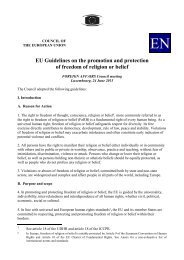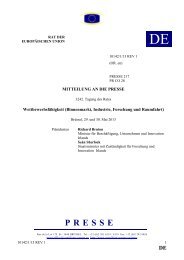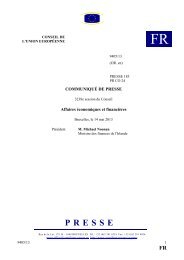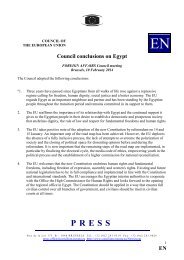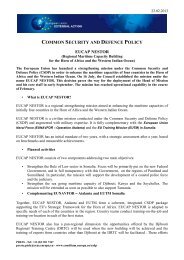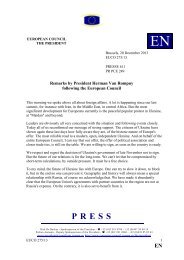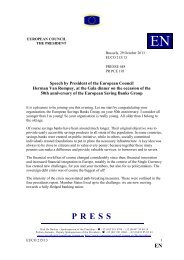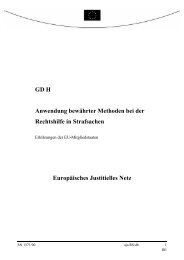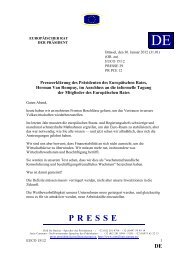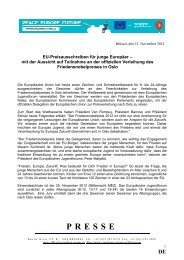14508/09 ADD 1 PL/vk 1 DG G COUNCIL OF THE ... - Europa
14508/09 ADD 1 PL/vk 1 DG G COUNCIL OF THE ... - Europa
14508/09 ADD 1 PL/vk 1 DG G COUNCIL OF THE ... - Europa
Create successful ePaper yourself
Turn your PDF publications into a flip-book with our unique Google optimized e-Paper software.
4.5.3. Trends emerging from EU-wide data<br />
In a set of questions in the French Presidency the survey, MS were asked whether they had trained<br />
staff involved in the areas of conflict and peace to take a gender approach. Seventeen MS said they<br />
had. Asked whether they had carried out gender mainstreaming in international actions, 19 MS said<br />
they had implemented action in the area of women and armed conflict. Questions were asked<br />
regarding 18 specific areas; as many as 15 MS had taken action in at least half of these areas. Thus,<br />
regarding indicator 1 it seems that action is being taken by many MS and that gender mainstreaming<br />
is being carried out in the area of military, defence and security although the extent of the activities<br />
in numerical terms is not known.<br />
On the number of women employed in the armed forces in 2007 there are Eurostat figures for only<br />
8 MS. The French Presidency’s survey collected data on this indicator in 2008, and there is data<br />
from NATO countries from 2007. The conclusion to be drawn from these data is that the gender gap<br />
in the MS' armed forces is enormous. The armed forces of all MS are almost completely dominated<br />
by men. In Finland and Poland men account for 99 %. Ten MS report 10 % or fewer women among<br />
the staff of their Armed Forces. The highest share of women in the armed forces (20 % and 17 %) is<br />
to be found in Hungary and Latvia.<br />
European military forces are and have historically been completely dominated by men. There are<br />
often different expectations of the citizenship of men and women in relationship to military<br />
activities. Most often women have not been required or allowed to do military service. This is<br />
clearly evident in conscription, which limits women’s possibilities of pursuing a military career.<br />
According to the statistics gathered by the French Presidency, the gender imbalance is further<br />
accentuated when staff of the MS’ armed forces are sent abroad. The percentage of women<br />
participating in international missions is consistently lower than their representation in the MS’<br />
armed forces. It ranges from less than 1 % (LA, MT) to 10 % (SE). The only exception is Sweden,<br />
with 4,5 % women in the national armed forces and 10 % in international missions.<br />
<strong>14508</strong>/<strong>09</strong> <strong>ADD</strong> 1 <strong>PL</strong>/<strong>vk</strong> 79<br />
ANNEX <strong>DG</strong> G EN



